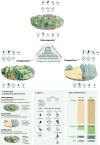Complex agricultural landscapes host more biodiversity than simple ones: A global meta-analysis
- PMID: 36095174
- PMCID: PMC9499564
- DOI: 10.1073/pnas.2203385119
Complex agricultural landscapes host more biodiversity than simple ones: A global meta-analysis
Abstract
Managing agricultural landscapes to support biodiversity conservation requires profound structural changes worldwide. Often, discussions are centered on management at the field level. However, a wide and growing body of evidence calls for zooming out and targeting agricultural policies, research, and interventions at the landscape level to halt and reverse the decline in biodiversity, increase biodiversity-mediated ecosystem services in agricultural landscapes, and improve the resilience and adaptability of these ecosystems. We conducted the most comprehensive assessment to date on landscape complexity effects on nondomesticated terrestrial biodiversity through a meta-analysis of 1,134 effect sizes from 157 peer-reviewed articles. Increasing landscape complexity through changes in composition, configuration, or heterogeneity significatively and positively affects biodiversity. More complex landscapes host more biodiversity (richness, abundance, and evenness) with potential benefits to sustainable agricultural production and conservation, and effects are likely underestimated. The few articles that assessed the combined contribution of linear (e.g., hedgerows) and areal (e.g., woodlots) elements resulted in a near-doubling of the effect sizes (i.e., biodiversity level) compared to the dominant number of studies measuring these elements separately. Similarly, positive effects on biodiversity are stronger in articles monitoring biodiversity for at least 2 y compared to the dominant 1-y monitoring efforts. Besides, positive and stronger effects exist when monitoring occurs in nonoverlapping landscapes, highlighting the need for long-term and robustly designed monitoring efforts. Living in harmony with nature will require shifting paradigms toward valuing and promoting multifunctional agriculture at the farm and landscape levels with a research agenda that untangles complex agricultural landscapes' contributions to people and nature under current and future conditions.
Keywords: agroecology; landscape agronomy; landscape composition; landscape configuration; landscape heterogeneity.
Conflict of interest statement
The authors declare no competing interest.
Figures



References
-
- Tilman D., et al. , Forecasting agriculturally driven environmental change. Am. Assoc. Adv. Sci. 292, 281–284 (2001). - PubMed
-
- Tscharntke T., et al. , Global food security, biodiversity conservation and the future of agricultural intensification. Biol. Conserv. 151, 53–59 (2012).
-
- Weltin M., et al. , Conceptualising fields of action for sustainable intensification—A systematic literature review and application to regional case studies. Agric. Ecosyst. Environ. 257, 68–80 (2018).
Publication types
MeSH terms
LinkOut - more resources
Full Text Sources

